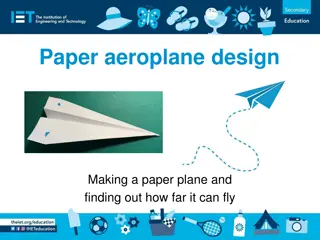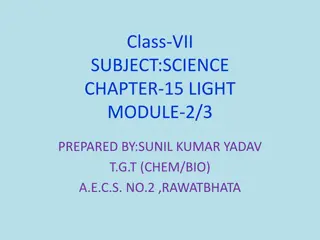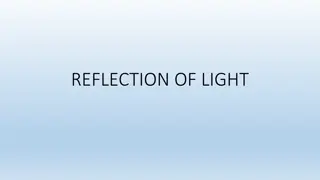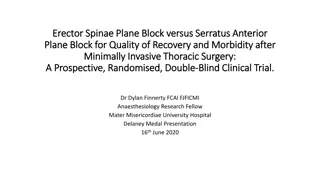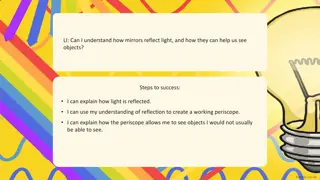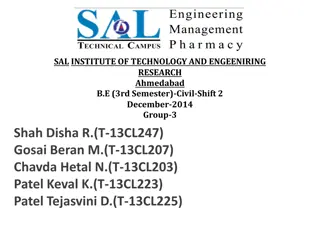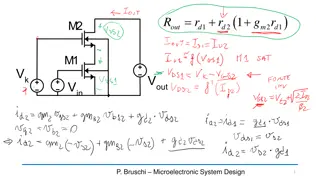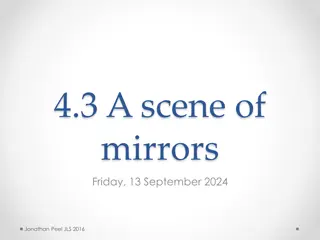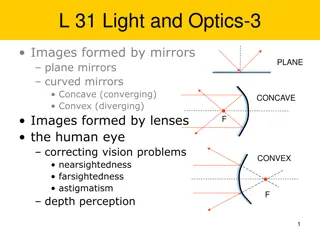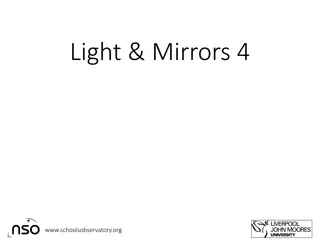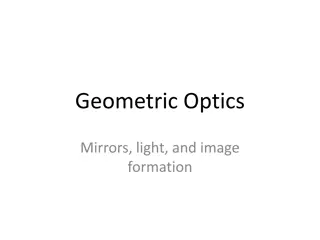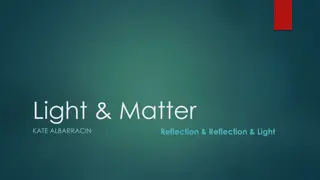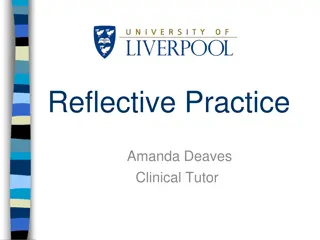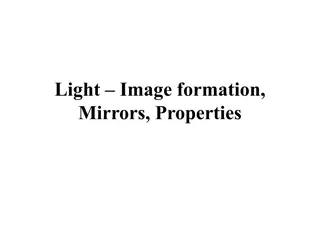Understanding Reflection in Plane Mirrors
Explore the laws and principles of reflection in plane mirrors through detailed explanations and visual demonstrations. Learn about diffuse and specular reflection, virtual images, ray tracing techniques, and the significance of parallax. Discover how to locate images using reflection and understand the practical applications of plane mirrors.
Download Presentation

Please find below an Image/Link to download the presentation.
The content on the website is provided AS IS for your information and personal use only. It may not be sold, licensed, or shared on other websites without obtaining consent from the author. Download presentation by click this link. If you encounter any issues during the download, it is possible that the publisher has removed the file from their server.
E N D
Presentation Transcript
Plane Reflection Learning Outcomes Use reflection keywords. State the laws of reflection. Demonstrate the laws of reflection. Discuss images formed in plane mirrors. Define virtual images. Use ray tracing to locate an image in a plane mirror. Discuss uses of plane mirrors. Understand parallax. Locate an image by no parallax. 1
Use Reflection Keywords If a surface is rough, light scatters in all directions and it can be seen from any direction. This applies to most objects. This is called diffuse reflection. 2 by Jeff Dahl CC-BY-SA-3.0
Use Reflection Keywords If a surface is smooth, light reflects only according to certain laws. These objects are called mirrors. This is called regular or specular reflection. We discuss regular reflection almost exclusively and usually just say reflection . 3 oint of inci ence nor l i r
Use Reflection Keywords The incident ray is the ray of light striking the mirror. The point of incidence is where the incident ray strikes the mirror. The reflected ray is the ray of light which has bounced off the mirror. The normal at the point of inci ence ( normal ) is n imaginary line at right angles to the mirror at the point of incidence. 4 oint of inci ence nor l i r
Use Reflection Keywords The angle of incidence, ? is the angle between the incident ray and the normal. The angle of reflection, ? is the angle between the reflected ray and the normal. NB: both angles are measured against the normal, not the mirror. 5 oint of inci ence nor l i r
State the Laws of Reflection 1. The incident ray, the normal at the point of incidence, and the reflected ray all lie in the same plane. 2. The angle of incidence is equal to the angle of reflection. (? = ?). 6
Demonstrate the Laws of Reflection 7 1. Draw a short line on a sheet of paper. 2. Place a mirror upright so that its back is on this line. 3. Aim a ray box with a narrowed beam at the back of the mirror. 4. M rk the be s th on the er before n fter striking the mirror with a pencil. r bo nor l i r l ss reflecti e bit
Demonstrate the Laws of Reflection 5. Remove the mirror and laser. 6. Draw the incident ray, the normal at the point of incidence, and the reflected ray on the paper. 7. These all lie in a plane parallel to the paper, verifying the first law. 8. Measure the angles of incidence and reflection. 9. These angles are equal, verifying the second law. 8
Use Ray Tracing to Locate an Image in a Plane Mirror Images in plane mirrors are virtual. Virtual images are formed by the apparent intersection of rays. NB: we say the image is behind the mirror , not in it. 9 e of
Problem: Shortest Mirror Standing in front of a mirror, what is the shortest the mirror can be so that you can see your whole body? Draw a diagram. 10 Some things that may help (but are not required): Assume your height is 2 m. Set the mirror to (e.g.) 2 m away. Put your eyes at the top of your head instead of on your face.
Problem: Shortest Mirror Half your height (if positioned correctly). 11
Discuss Uses of Plane Mirrors Bathroom mirrors are plane they can be used to check appearance. Periscopes use two plane mirrors to allow you to see over or around objects. 12
Take a Step Back Imagine you are standing in front of a mirror just tall enough that you can see from the top of your head to your knees. When you take a step back, you can see: A. Less of yourself B. More of yourself C. The same amount of yourself 13
Locate an Image by No Parallax Parallax is a difference in the apparent position of an object due to the position of an observer. 1. Draw a mark on a nearby wall. 2. Place a metre stick vertically on your table. 3. Close one eye, and move the metre stick and your head until the metre stick blocks the mark. 4. Keeping the metre stick in place, move your head until the mark appears again. 5. This is parallax moving your head appears to move the metre stick from in front of the mark. 14
Locate an Image by No Parallax 1. Stand a plane mirror upright on a sheet of paper on a flat surface. 2. St n n object in u ri ht ne r the irror, keeping it in place with Blutack. 3. Lookin into the irror, o e secon se rch in behind the mirror and align it with the image of the object pin. 4. By moving your head and the search pin, find where there is no parallax between the image and the search pin. 5. Mark the position of the object and search pins, and the plane mirror on the paper. 16
Locate and Image by No Parallax 6. Measure and compare the distances from the plane mirror to the object pin and the image. 17



